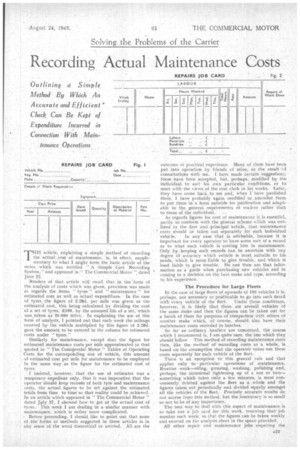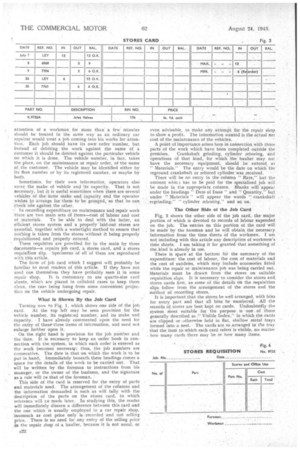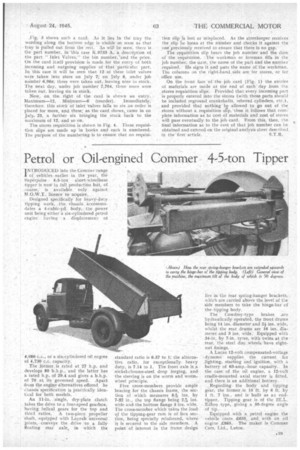Recording Actual Maintenance Costs
Page 23

Page 24

Page 25

If you've noticed an error in this article please click here to report it so we can fix it.
IS article, explaining a simple .method of recording
the actual .cost of maintenance, is, in effect, supple mentary to what I might term the basic article of the series which was entitled " A Simple Cost Recording System," and appeared in " The Commercial Motor dated June 22.
Readers of that article will recall that in the-form of the analysis of costs which was given, provision was made as regards the items " tyres and maintenance '' for estimated cost as well as actual expenditure,. In the case of tyres the figure of 2.28d. per mile was given as the estimated cost, this being calculated by dividing the cost of a set of tyres, gm,. by the assumed life of a set, 'which was taken as 20.000 miles. In explaining the use of this form of analysis, I pointed out that each week the mileage covered by the vehicle multiplied by this figure of 2.28d. gave the amount to be entered in the column for estimated costs under " tyres."
Similarly for maintenance, except that. the figure for estimated maintenance costs per mile approximated to that quoted in " The Commercial Motor " Tables of Operating Costs for the corresponding size of vehicle, this amount of estimated cost per mile for Maintenance to be employed in the same way as the figure for the estimated cost of tyres.
I insisted, however, that .the use of estimates was a temporary expedient only, that it was imperative that the operator should keep records of both tyre and maintenance costs, the actual figures to be set against the estiniated totals from time to time 5o that reality could be achieved. In an article which appeared in " The Commercial Motor" dated Lily 27, .I .showed how to get at the actual cost of tyres. This week I am dealing in a Similar manner with maintenance, which is rather more complicated.
Before proceeding, I should like to point out that none of . the forms or methods suggested in these articles is in any sense of the word theoretical or untried. , All are the
outcome ot practical experience. Many of them have been put into operation. by friends of mine; as the Jesult 'of consultations With me. I have madei....ertain suggestionc; these have been accepted, but, perhaps, modified by the individual to suit his own particular conditions, or to meet with the Niews of the cost clerk in his works. Later, they have come back, to me and, when I have published them, I have piobably again modified' or amended them to put them in a form suitable for ptiblication and adaptable to the general recjairements of readers rather than
to-those of the mdiVidual. _ As regards figures for cost of maintenance it is essential, partly to conform with the general scheme which was outlined in the first and principal 'article, that Maintenance costs should be taken out separately for each individual vehicle. In any case that is advisable, because it is important for every operator to have some sort of a record as to what each vehicle is costing him in maintenance. Only by keeping such records can he ascertain with any degree Of accuracy which vehicle is most suitable to his needs, which is mostliable to give trouble, and Witich is least liable to give trouble. He can then use that information as a guide when purchasing new vehicles and in coming to a decision on the best make and 'type, according to his experience.
The Procedure for Large Fleets In the case of large fleets of upwards of 100 vehicles it-is, perhaps, not necessary or pratticable to go into such detail
with every vehicle of the fleet. Under those conditions, however, it is likely that there are seVeral vehicles of the same make and then the figures can be taken out for a batch of them for purposes of comparison With others of another make which, of course; should also have their maintenance costs recorded in batches.
So far as ordinary hauliers are concerned, the course which I recommend is, I am quite sure, the one which they should 'follow This method of recording maintenance Costs then, like the method of recording costs as a whole, is based on the assumption that the operator takes -out these costs separately for each vehicle of the fleet.
There is an exception to this general rule and that applies only to, particular operations of maintenance. Routine work—oiling, greasing, washing, polishing and, perhaps, -the occasional tightening up of a nut or two— something which takes only a few minutes, is most conveniently 'debited against the fleet as a whole and the figures taken out periodically and divided equally amongst all the vehicles of the fleet. Precisely accurate results donot accr'ue from this method, but the inaccuracy is so small as not to be of any importance.
The best way to deal with this aspect of maintenance is to take out a job card for this work, renewing that' job number each week, so that the figures can he taken weekly and entered on the analysis sheet in the space prbvided.
All other repair and maintenance jobs requiring -the A21.
attention of a workman for more than a few' minutes should be treated in the same way • as an ordinary car repairer would treat a job coming into his works for attention, Each job should have its own order number, but instead of debiting the work against the name of a customer it should be debited against the particular vehicle on which it is done. The vehicle number, in fact, takes the place, on the maintenance or repair order, of the name of, the customer. The vehicle may be identified either by its fleet number or by its registered number, or maybe by both.
Sometimes, for their own information, operators also enter the make of vehicle and its capacity. That is not necessary, but it is useful sometinnes when there are several vehicles of the 'Same 'make and capacity and the operator wishes to arrange for them to be grouped, so that he can check one against the other.
' In recording expenditure on maintenance and repair work there' are two main sets of items—Cost of labour and cost
of materials. To be able to deal with the latter, an efficient stores system and a properly "laid-out stores are essential, together with a watertight method to ensure that nothing is taken from the stores without it being properly requisitioned and properly entered.
These requisites are provided for in the main by three documents—a repairs job card, a Stores card, and a stores requisilion slip. Specimens of all of them are reproduced with this article.
The form of job card which I suggest will probably be familiar to most readers of this article-. If they have not used one themselves they have probably seen it in some
repair shop, It is customary to use quarto-size card sheets, which are placed in celluloid cases to keep them clean, the casa being hung from some convenient projection on the vehicle undergoing repair.
What is Shown By the Job Card
Turning no to Fig. I, which shows one side of the job card. at the top left may be seen provision for the vehicle number, its registe:cd number, and its make and capacity. I have already commented 'upon the need for the entry of these-three items of infcrmation, and need not enlarge further upon it.
On the right hand is provision for the job number and the date. It is necessary to keep an order book in connection with the system, in which each order is entered as the work becomes necessary; thus, the job numbers are consecutive. The date is that an which the Work is to be put in hand, -Immediately beneath these headings comes a space for the details of the work to be carried out. That will be written by the foreman to instructions from his manager, or the owner of the business, and the signature as a rule will be that of the foreman.
This side of the card is reserved for the entry of parts and materials used. The arrangement of the columns and the information demanded is such as will tally with the description of the parts on the stores card, to which -reference will Le made later. In studying this, the reader will immediately discern a difference between this card and the one which is usually employed in a car repair shop, inasmuch as cost price only is .recorded and not selling price. There is no need for any entry of the selling price in the repair shop of a hardier, because it is not usual, or
even advisable, to make any attempt for the repair shop to show a profit. The information wanted is the actual net . cost of the maintenance of the vehicles.
A point of importance arises here in connection with those parts of the work which have been completed outside the premises. Crankshaft grinding, cylinder reboring, and operations of that kind, for which 'the haulier may not have the necessary equipment, should be entered as • " Materials." The entry would be the date on which the reground crankshaft or rebored cylinder was received.
There will be no entry in the column " Rate," but the amount wbic r has to be paid for 'the specialized job will be made in the appropriate column. Blanks will appear under the headings " Date of Issue " and " Quantity," but .under " Materials" will appear the words " crankshaft regrinding," "cylinder reboring," and so. on.
The Other Side of the Job Card
Fig. 2 shows the other side of the job card, the major portion of which is devoted to records of labour expended on the job. The entries on this portion of the card will he made by the foreman and he will obtain, the necessary information from the time sheets of the workmen. I am not including with this article any description of workmen's time sheets. I am taking it for granted that something of the-kind is already in use.
There is space at the bottom for the summary of the expenditure: the cost of labour, the cost of materials and the cost of sundries, which may include accessories fitted while the repair or maintenance job was being carried out. Materials must be drawn from the stores on suitable requisition slips. It is necessary to consider the stores and stores cards first, as some of the details on the requisition slips follow from the arrangement of the stores and the method of recording stores.
It is important that the stores be well arranged, with bins for every part and that all bins be numbered. All the records Of stores are best kept on cards. Undoubtedly the system most suitable for the purpose is one of those generally described as." Visible Index," in which the cards are clipped or otherwise held in flat, shallow metal trays formed into a nest. The cards are so arranged in the tray that the item to which each card refers is visible, no matter how many cards there may be or how many items. ,Fig. :3 shows such a card. As it lies in the tray the wording along the bottom edge is visible so soon as that tray is pulled out front the' rest. As will be seen, there is the part number, in this case K.9733. A. a description of the part •'' Inlet Valves," the bin number,'and the price. On the card itself provision is made for the entry of both incoming and outgoing supplies of that particular part. In this case it will be seen that 12 . of these inlet valves were taken into store on July 7; on July 8, under job number 6.966; three were taken out, leaving nine io stock. The next day, under job number 7,704, three' more were taken out leaving six in stock.
Now, on the. right of the card is shown an entry, Maximum-12, Minimum6 (reorder). Immediately,therefore, this steick of inlet valves falls to six an order is placed for more, and. these; as the card shows, came in on July. 23, a further she bringing the Stock i;ack to the maximum of 12, and so on.
The stores requisition isshOwn in Fig. 4. These requisition slips are made up in boOks and each is numbered. The purpose of the numbering is to ensure that no requisi
firm slip is lost or -misplaced. As the storekeeper receives the slip he looks at the thimber and checks it against the one previouslyreceived to ensure that there is no gap: The requiSitian slip bears the job number, and the date of the requisition. 1.he workman or foreman tills in the job number, the date, the name of the part and the number required. He signs it and puts the name of the workman. The columns on the right-hand.side are for stores, or for Office use, On the front face of the job card (Fig. 1) the entries of materials are made at the end of each day from "the stares requisition slips. Provided that every incoming part 'is properly entered into the stores (with those parts should be included reground crankshafts, rebored cylinders, etc.), and provided that nothing be. allowed to go out of the stores without a requisition slip, " then it follows that complete information a. to cost of materials and cost of stores will pass' eventually_ to the job card. From this, then, the final information as .to the cost of that job number can be obtained and entered on the original analysis sheet described.
in the first article. S.T.R.




















































